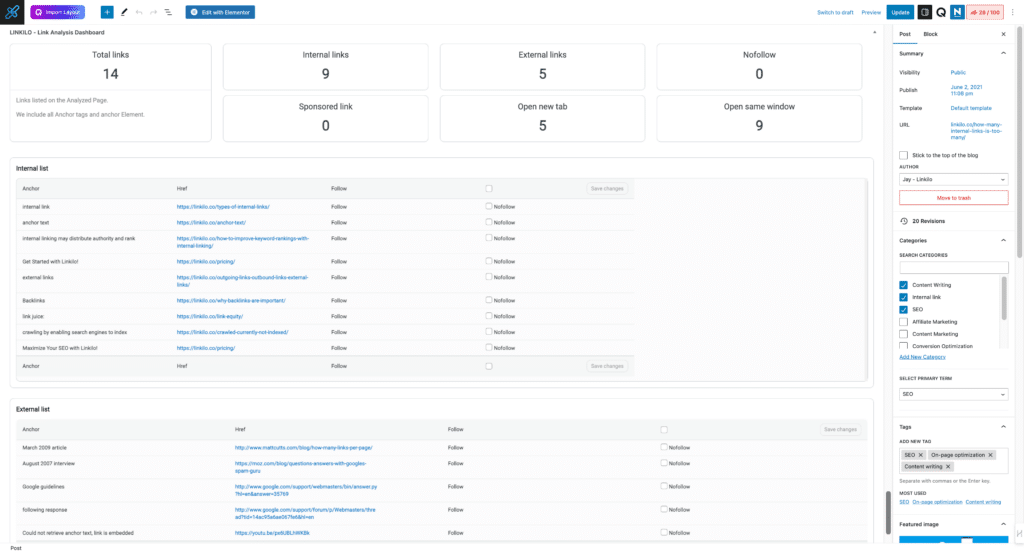For a long time, some have recognized that having too many internal links might have a detrimental influence. This is although they are beneficial for SEO.
Table of Contents
The definition of internal linking
An internal link is a link that links one page of a website to another within the same website. The source and destination domains of an internal link are the same.
Optimal format for internal linking
In anchor text, use descriptive keywords that offer a sense of the subject or keywords the source website is attempting to target.
What is the purpose of internal linking?
Internal linking serves three primary functions:
- It assists with website navigation.
- It defines a website’s architecture and structure.
- It disseminates page and ranking authority throughout the site.
We will spend most of our time examining the third issue: how internal linking may distribute authority and rank across many website pages.
The maximum amount of links that should be placed on any page has long been a source of debate in SEO.
Optimize Your Internal Linking Strategy Today!
Internal links play a crucial role in website navigation, structure, and ranking authority. But how many internal links are too many? Discover the optimal balance for your website with Linkilo—an all-in-one tool designed to improve your site’s internal linking strategy and enhance your SEO efforts.
Get Started with Linkilo! Elevate your site’s performance with smart internal linking!How many are too many internal links?
The 100 links per page restriction originated with Google and has been reiterated for years, most recently in a March 2009 article by Matt Cutts. He references Google rules as saying, “Keep the links on a particular page to a sensible amount (fewer than 100).”
How many are too many internal links? “More than 100 internal links on a single page are excessive.” Google further said, “Google may opt not to follow or crawl all those links” if a website has above 100 internal links. Google also said that you would be “splitting the PageRank of that page over hundreds of links” by having excessive internal links.
Those are bold claims, so it is no wonder that the rule of thumb of 100 internal links has been maintained throughout the years.
But should web admins still adhere to Google’s guidelines?
Due to bandwidth constraints, early crawlers limited the amount of data they would analyze for each particular website. Finally, 100 links proved a decent rule of thumb for what would fit on a webpage that fulfilled those processing restrictions.
Could you be penalized for too many links?

Rand follows Matt Cutts to highlight Google Rules’ words, ‘keep the number of links to under 100’, in an August 2007 interview. He then says that it applies in the technical guideline section and not the quality guideline section. That is, if you have 101 or 102 links on a page, Google will not delete them. So, consider this more of a guideline.
At the time, Google was certainly rejecting links after a specific threshold, but this helped prevent post-100 links from going beyond PageRank.
Is 100 links still the limit?
The word “fewer than 100” seems to have been removed from the Google guidelines page Matt cites after his 2009 reply. This change has been confirmed by observations from the SEO community and various Google Webmaster Help forums. Google supported the following response in April 2010:
“This, like several other Google “limits,” is unlikely to be a fixed quantity and will defer by site authority. It is also possible that the figure has risen over time as Google overcomes processing constraints (especially post-caffeine).”
So, is it still relevant?
The simple response is ‘yes. In SEO, it is unavoidable that the more links a page have, the less internal PageRank each link transmits. To quote Matt again, from his discussion with Rand: “In any case, you are distributing that page’s PageRank over hundreds of links, so each link will only send along a small amount of PageRank anyhow.”
Quality trumps quantity when it comes to internal links

You may include contextual links to relevant content on the site when adding internal links to something like a blog entry.
While some internal links are beneficial, more is not always better. With fewer linkages, you can deliver stronger signals.
According to John Mueller’s response to too many internal links:
“Yes and no. I think, in the sense that we do use the internal links to better understand the structure of a page, and you can imagine the situation where if we’re trying to understand the structure of a website, with the different pages that are out there, if all pages are linked to all other pages on the website, where you essentially have like a complete internal linking across every single page, then there’s no real structure there.
It’s like this one giant mass of pages for this website, and they’re all interlinked, we can’t figure out which one is the most important one. We can’t figure out which one of these are related to each other. And in a case like that, having all of those internal links, that’s not really doing your site that much.
So regardless of what PageRank, and authority, and passing things like that, you’re essentially not providing a clear structure of the website. And that makes it harder for search engines to understand the context of the individual pages within your website. So that’s the way that I would look at it there.”
“And similar to the second question you had there, with regards to internal links doing more harm than good — yes, if you do dilute the value of your site structure by having so many internal links that we don’t see a structure anymore, then that does make it harder for us to understand what you think is important on your website.
And I think providing that relative sense of importance is sometimes really valuable, because it gives you a little bit more opportunity to kind of fine tune how you’d like to be present in the search results.
If you tell search engines pretty clearly and directly, well this is my primary page, and from there you link to different categories and the categories link to different products, then it’s a lot easier for us to understand that if someone is looking for this category of product, this is that page that we should be showing in the search results.
Whereas if everything is cross-linked then it’s like, well any of these pages could be relevant. And then maybe we’ll send the user to some random product instead of to your category page when you’re actually looking for a category of products.”
Hear Mueller’s full response in the video during the Google Search Central SEO hangout recorded on July 2, 2021, below:
What is the significance of internal link building in SEO?
If you are reading this, you are probably aware of what links are; you probably know that link building is an important element of SEO. However, when we mention link building, we usually mean getting external links to the website rather than internal links.
Backlinks are a well-known ranking component. When a page receives many external links pointing to it, its authority rises, and Google boosts it in search results. Internal links are seldom given the attention they deserve, even though they play a significant part in a website’s health: from crawlability by search engine bots to ranking authority distribution throughout a website’s pages.
1. Internal links increase the authority of your site
Internal links are most significant because they can convey link juice: they can tell Google which pages on your website are more significant.
Internal links do not convey nearly as much link juice as backlinks, and they do not raise your website’s authority, but they may help you move some of your pages up in search results.
An effective internal linking strategy will assist you in developing the most efficient hierarchy of your pages inside the site design.
2. Internal linking encourages visitors to spend more time on your website
Internal linking is largely utilized for website navigation and keeping a simple website structure. While this is largely a user experience advantage, a logical website layout saves you money on crawling by enabling search engines to index more pages on each visit. This takes us to point three.
3. Internal links contribute to effective site design
To handle internal link building, you will need certain high-quality SEO tools like ours to save time and get better results. Check out our internal linking plugin for WordPress.

Conclusion – What is the right number?
There is no one solution to so many difficult SEOs (and I am speaking just from an SEO viewpoint).
There is a fine line between developing a site structure that is too deep (resulting in pages that are many links distant from high-authority sites) and too flat (giving rise to a scenario similar to the one described above). While many SEOs advocate flat design, the fundamental issue is that they regard every link as equal.
Do you have 150 (or more) pages that all deserve the same treatment from the home page and should all have the same PageRank or Juice? Most likely not!
So, we use a balanced and hierarchical strategy, concentrating internal PageRank on the most critical sites. Finally, though it may be outdated, the 100-link rule is a good starting point for most sites.
Ready to Fine-Tune Your Internal Linking Hierarchy?
While internal links are essential, it’s all about finding the right balance. Excessive linking can dilute your site structure, but Linkilo is here to help. With our powerful SEO tool, you can develop an effective hierarchical strategy that focuses PageRank on your most important pages, ensuring a better user experience and higher search rankings.
Maximize Your SEO with Linkilo! Take the first step towards a well-structured website!




